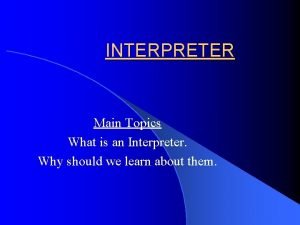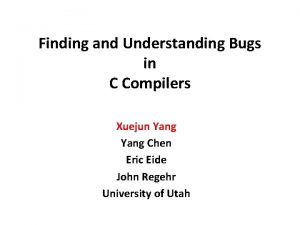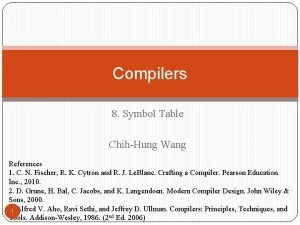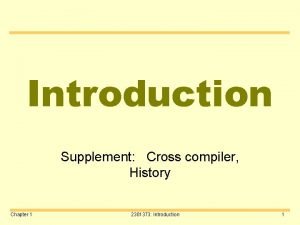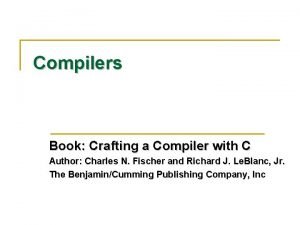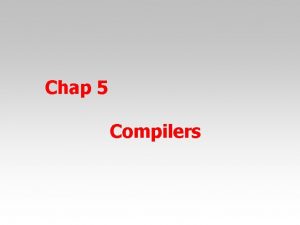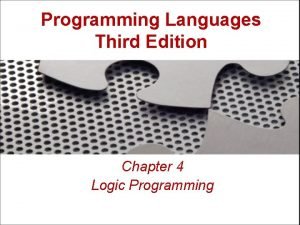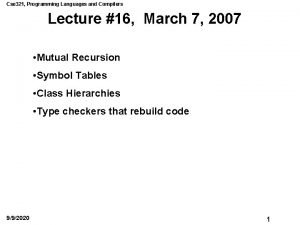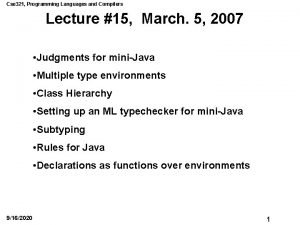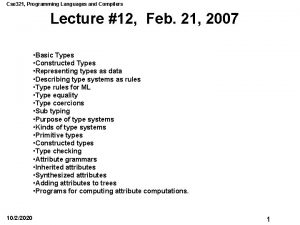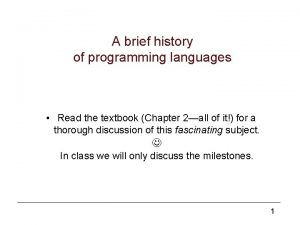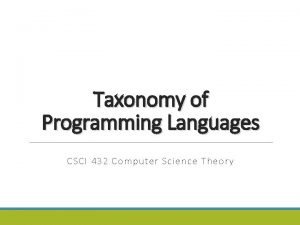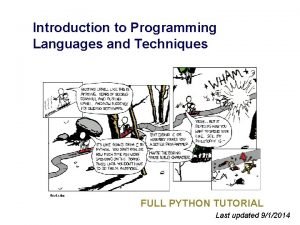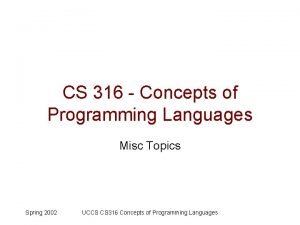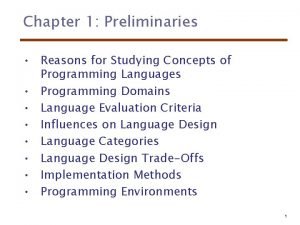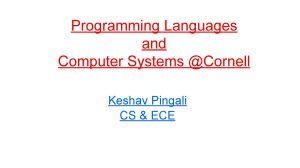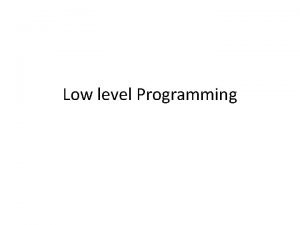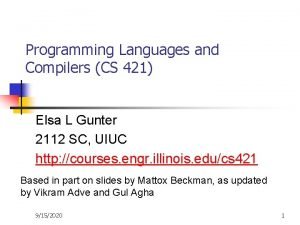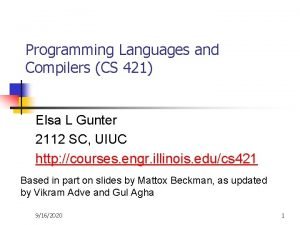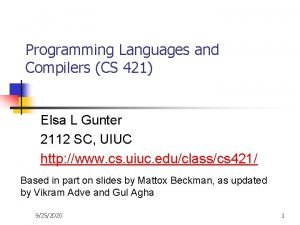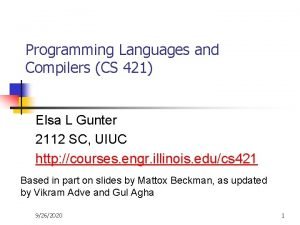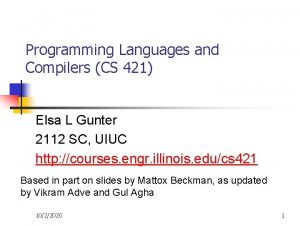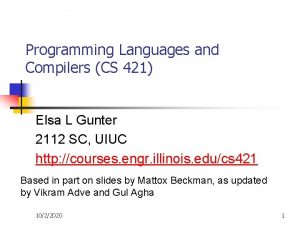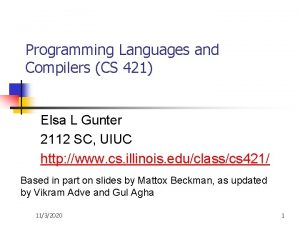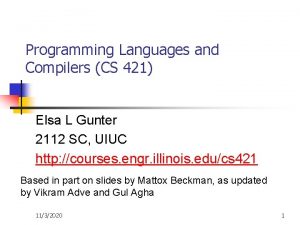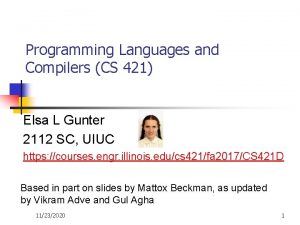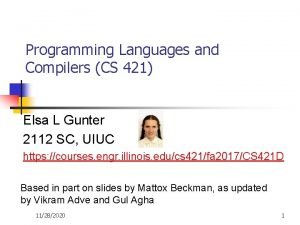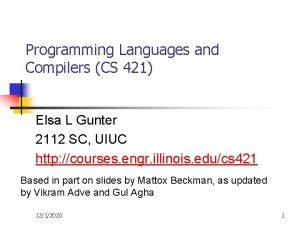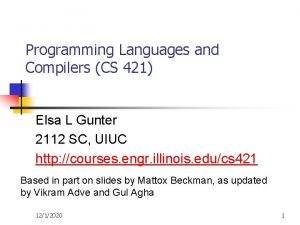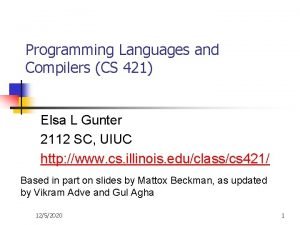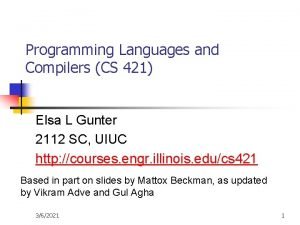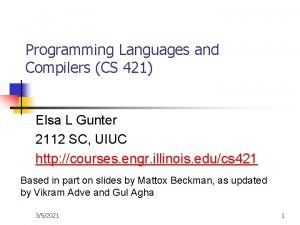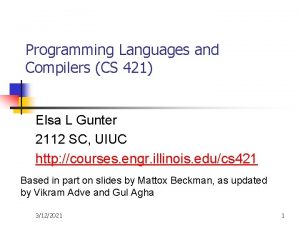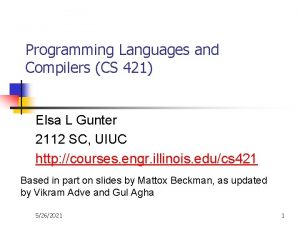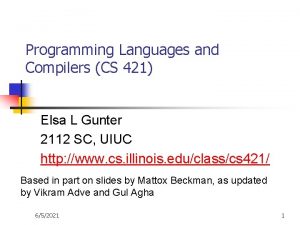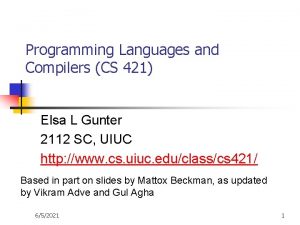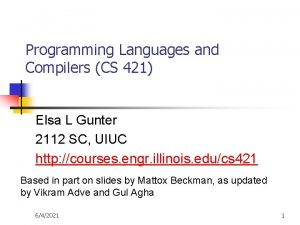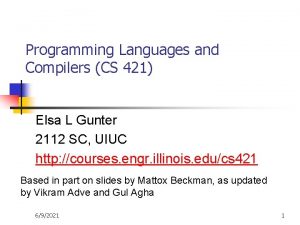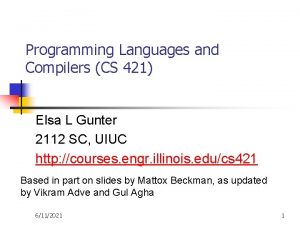Programming Languages and Compilers CS 421 Elsa L







































- Slides: 39

Programming Languages and Compilers (CS 421) Elsa L Gunter 2112 SC, UIUC http: //courses. engr. illinois. edu/cs 421 Based in part on slides by Mattox Beckman, as updated by Vikram Adve and Gul Agha 3/11/2021 1

Background for Unification n n Terms made from constructors and variables (for the simple first order case) Constructors may be applied to arguments (other terms) to make new terms Variables and constructors with no arguments are base cases Constructors applied to different number of arguments (arity) considered different Substitution of terms for variables 3/11/2021 2

Simple Implementation Background type term = Variable of string | Const of (string * term list) let rec subst var_name residue term = match term with Variable name -> if var_name = name then residue else term | Const (c, tys) -> Const (c, List. map (subst var_name residue) tys); ; 3/11/2021 3

Unification Problem Given a set of pairs of terms (“equations”) {(s 1, t 1), (s 2, t 2), …, (sn, tn)} (the unification problem) does there exist a substitution (the unification solution) of terms for variables such that (si) = (ti), for all i = 1, …, n? 3/11/2021 4

Uses for Unification Type Inference and type checking n Pattern matching as in OCAML n n Can use a simplified version of algorithm Logic Programming - Prolog n Simple parsing n 3/11/2021 5

Unification Algorithm n n n Let S = {(s 1, t 1), (s 2, t 2), …, (sn, tn)} be a unification problem. Case S = { }: Unif(S) = Identity function (i. e. , no substitution) Case S = {(s, t)} S’: Four main steps 3/11/2021 6

Unification Algorithm n n n Delete: if s = t (they are the same term) then Unif(S) = Unif(S’) Decompose: if s = f(q 1, … , qm) and t =f(r 1, … , rm) (same f, same m!), then Unif(S) = Unif({(q 1, r 1), …, (qm, rm)} S’) Orient: if t = x is a variable, and s is not a variable, Unif(S) = Unif ({(x, s)} S’) 3/11/2021 7

Unification Algorithm n Eliminate: if s = x is a variable, and x does not occur in t (the occurs check), then Let = x | t n Let = Unif( (S’)) n Unif(S) = {x | (t)} o n n 3/11/2021 Note: {x | a} o {y | b} = {y | ({x | a}(b))} o {x | a} if y not in a 8

Tricks for Efficient Unification Don’t return substitution, rather do it incrementally n Make substitution be constant time n Requires implementation of terms to use mutable structures (or possibly lazy structures) n We won’t discuss these n 3/11/2021 9

Example n x, y, z variables, f, g constructors n S = {(f(x), f(g(y, z))), (g(y, f(y)), x)} 3/11/2021 10

Example n x, y, z variables, f, g constructors S is nonempty n S = {(f(x), f(g(y, z))), (g(y, f(y)), x)} n 3/11/2021 11

Example n x, y, z variables, f, g constructors Pick a pair: (g(y, f(y)), x) n S = {(f(x), f(g(y, z))), (g(y, f(y)), x)} n 3/11/2021 12

Example n n n x, y, z variables, f, g constructors Pick a pair: (g(y, f(y))), x) Orient: (x, g(y, f(y))) S = {(f(x), f(g(y, z))), (g(y, f(y)), x)} -> {(f(x), f(g(y, z))), (x, g(y, f(y)))} 3/11/2021 13

Example n x, y, z variables, f, g constructors n S -> {(f(x), f(g(y, z))), (x, g(y, f(y)))} 3/11/2021 14

Example n x, y, z variables, f, g constructors Pick a pair: (f(x), f(g(y, z))) n S -> {(f(x), f(g(y, z))), (x, g(y, f(y)))} n 3/11/2021 15

Example n n n x, y, z variables, f, g constructors Pick a pair: (f(x), f(g(y, z))) Decompose: (x, g(y, z)) S -> {(f(x), f(g(y, z))), (x, g(y, f(y)))} -> {(x, g(y, z)), (x, g(y, f(y)))} 3/11/2021 16

Example n x, y, z variables, f, g constructors Pick a pair: (x, g(y, f(y))) Substitute: {x |-> g(y, f(y))} S -> {(x, g(y, z)), (x, g(y, f(y)))} -> {(g(y, f(y)), g(y, z))} n With {x |-> g(y, f(y))} n n 3/11/2021 17

Example n x, y, z variables, f, g constructors Pick a pair: (g(y, f(y)), g(y, z)) n S -> {(g(y, f(y)), g(y, z))} n With {x | g(y, f(y))} 3/11/2021 18

Example n n n x, y, z variables, f, g constructors Pick a pair: (g(y, f(y)), g(y, z)) Decompose: (y, y) and (f(y), z) S -> {(g(y, f(y)), g(y, z))} -> {(y, y), (f(y), z)} With {x | g(y, f(y))} 3/11/2021 19

Example n x, y, z variables, f, g constructors Pick a pair: (y, y) n S -> {(y, y), (f(y), z)} n With {x | g(y, f(y))} 3/11/2021 20

Example n n n x, y, z variables, f, g constructors Pick a pair: (y, y) Delete S -> {(y, y), (f(y), z)} -> {(f(y), z)} With {x | g(y, f(y))} 3/11/2021 21

Example n x, y, z variables, f, g constructors Pick a pair: (f(y), z) n S -> {(f(y), z)} n With {x | g(y, f(y))} 3/11/2021 22

Example n n n x, y, z variables, f, g constructors Pick a pair: (f(y), z) Orient: (z, f(y)) S -> {(f(y), z)} -> {(z, f(y))} With {x | g(y, f(y))} 3/11/2021 23

Example n x, y, z variables, f, g constructors Pick a pair: (z, f(y)) n S -> {(z, f(y))} n With {x | g(y, f(y))} 3/11/2021 24

Example n n n x, y, z variables, f, g constructors Pick a pair: (z, f(y)) Eliminate: {z|-> f(y)} S -> {(z, f(y))} -> { } With {x | {z | f(y)} (g(y, f(y))) } o {z | f(y)} 3/11/2021 25

Example n n n x, y, z variables, f, g constructors Pick a pair: (z, f(y)) Eliminate: {z|-> f(y)} S -> {(z, f(y))} -> { } With {x | g(y, f(y))} o {(z | f(y))} 3/11/2021 26

Example S = {(f(x), f(g(y, z))), (g(y, f(y)), x)} Solved by {x | g(y, f(y))} o {(z | f(y))} f(g(y, f(y))) = f(g(y, f(y))) x z and g(y, f(y)) = g(y, f(y)) x 3/11/2021 27

Example of Failure: Decompose n n n n S = {(f(x, g(y)), f(h(y), x))} Decompose: (f(x, g(y)), f(h(y), x)) S -> {(x, h(y)), (g(y), x)} Orient: (g(y), x) S -> {(x, h(y)), (x, g(y))} Eliminate: (x, h(y)) S -> {(h(y), g(y))} with {x | h(y)} No rule to apply! Decompose fails! 3/11/2021 28

Example of Failure: Occurs Check n n n S = {(f(x, g(x)), f(h(x), x))} Decompose: (f(x, g(x)), f(h(x), x)) S -> {(x, h(x)), (g(x), x)} Orient: (g(y), x) S -> {(x, h(x)), (x, g(x))} No rules apply. 3/11/2021 29

Major Phases of a Compiler Optimized IR Source Program Relocatable Lex Instruction Object Code Selection Tokens Linker Parse Unoptimized Machine. Abstract Syntax Specific Assembly Language Machine Semantic Code Optimize Analysis Optimized Machine-Specific Symbol Table Assembly Language Translate Emit code Intermediate Assembly Language Representation Assembler Modified from “Modern Compiler Implementation in ML”, by Andrew Appel

Meta-discourse n n n Language Syntax and Semantics Syntax - Regular Expressions, DFSAs and NDFSAs - Grammars Semantics - Natural Semantics - Transition Semantics 3/11/2021 31

Language Syntax n n n Syntax is the description of which strings of symbols are meaningful expressions in a language It takes more than syntax to understand a language; need meaning (semantics) too Syntax is the entry point 3/11/2021 32

Syntax of English Language n Pattern 1 n Pattern 2 3/11/2021 33

Elements of Syntax n n n n Character set – previously always ASCII, now often 64 character sets Keywords – usually reserved Special constants – cannot be assigned to Identifiers – can be assigned to Operator symbols Delimiters (parenthesis, braces, brackets) Blanks (aka white space) 3/11/2021 34

Elements of Syntax n Expressions if. . . then begin. . . ; . . . end else begin. . . ; . . . end n Type expressions typexpr 1 -> typexpr 2 n Declarations (in functional languages) let pattern 1 = expr 1 in expr n Statements (in imperative languages) a = b + c n Subprograms let pattern 1 = let rec inner = … in expr 3/11/2021 35

Elements of Syntax Modules n Interfaces n Classes (for object-oriented languages) n 3/11/2021 36

Lexing and Parsing n Converting strings to abstract syntax trees done in two phases n Lexing: Converting string (or streams of characters) into lists (or streams) of tokens (the “words” of the language) n n Specification Technique: Regular Expressions Parsing: Convert a list of tokens into an abstract syntax tree n 3/11/2021 Specification Technique: BNF Grammars 37

Formal Language Descriptions n n n Regular expressions, regular grammars, finite state automata Context-free grammars, BNF grammars, syntax diagrams Whole family more of grammars and automata – covered in automata theory 3/11/2021 38

Grammars n n Grammars are formal descriptions of which strings over a given character set are in a particular language Language designers write grammar Language implementers use grammar to know what programs to accept Language users use grammar to know how to write legitimate programs 3/11/2021 39
 Cs 421 programming languages and compilers
Cs 421 programming languages and compilers Cs 421 uiuc
Cs 421 uiuc Pros and cons of compilers and interpreters
Pros and cons of compilers and interpreters Finding and understanding bugs in c compilers
Finding and understanding bugs in c compilers Compilers: principles, techniques, and tools
Compilers: principles, techniques, and tools Compilers and interpreters are themselves
Compilers and interpreters are themselves Real-time systems and programming languages
Real-time systems and programming languages Advantages and disadvantages of system software
Advantages and disadvantages of system software Real-time systems and programming languages
Real-time systems and programming languages Binarymove c++
Binarymove c++ Cousins of compiler
Cousins of compiler Crafting a compiler
Crafting a compiler Function of compiler
Function of compiler Front end in compiler design
Front end in compiler design Real time example of multithreading in java
Real time example of multithreading in java Cxc it
Cxc it Introduction to programming languages
Introduction to programming languages Plc programming languages
Plc programming languages Joey paquet
Joey paquet Imperative programming languages
Imperative programming languages Alternative programming languages
Alternative programming languages Strongly typed vs weakly typed
Strongly typed vs weakly typed Transmission programming languages
Transmission programming languages Cse 340 principles of programming languages
Cse 340 principles of programming languages Integral data type is
Integral data type is Xenia programming languages
Xenia programming languages Mainstream programming languages
Mainstream programming languages Vineeth kashyap
Vineeth kashyap Programming languages
Programming languages Programming languages
Programming languages Programming languages
Programming languages Programming languages
Programming languages Language
Language Brief history of programming languages
Brief history of programming languages Taxonomy of programming languages
Taxonomy of programming languages Xkcd functional programming
Xkcd functional programming If programming languages were cars
If programming languages were cars Reasons for studying concepts of programming languages
Reasons for studying concepts of programming languages Cornell programming languages
Cornell programming languages Low level programming language
Low level programming language


